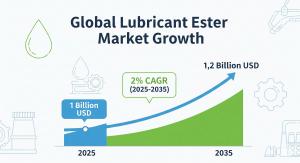Lubricant Ester Market is Expected to Reach a Valuation of USD 1.2 Billion by 2035 | FactMR Report
Lubricant ester market is growing steadily, driven by demand for high-performance, eco-friendly lubricants across automotive, aviation, renewable energy sectors
ROCKVILLE, MD, UNITED STATES, August 21, 2025 /EINPresswire.com/ -- The Lubricant Ester Market is segmented by ester type, application, and region, with each category playing a critical role in shaping its overall trajectory. The market represents a key part of the broader synthetic lubricants industry, catering to sectors where performance, durability, and environmental compliance are increasingly vital. By examining these segments in detail, stakeholders gain a clearer picture of where demand is most concentrated and where emerging opportunities lie.As of 2025, the global market is valued at USD 1 billion, with projections estimating growth to USD 1.2 billion by 2035. This reflects a steady compound annual growth rate (CAGR) of 2 percent during the forecast period. Although modest, the growth underscores consistent demand driven by applications that require advanced lubricants capable of withstanding high stress, extreme temperatures, and sustainability regulations.
For More Insights into the Market, Request a Sample of this Report: https://www.factmr.com/connectus/sample?flag=S&rep_id=8913
Lubricant Ester Market Projections & Growth Trajectory
The market’s projected expansion is tied closely to global trends in automotive efficiency, aviation safety, and industrial durability. Synthetic esters are increasingly favored as replacements for conventional lubricants, largely due to their superior thermal stability, low volatility, and environmental friendliness. From its 2025 baseline of USD 1 billion, the market’s progression to USD 1.2 billion by 2035 will rely on innovations tailored for demanding environments such as aerospace engines, automotive transmissions, and wind turbine gearboxes.
By Ester Type: Leaders & Fastest Movers
Among the types of esters available, polyol esters dominate the market thanks to their exceptional thermal resistance, lubricity, and additive compatibility. These characteristics make them a preferred choice in high-performance applications like aviation turbine engines and industrial systems operating under extreme stress.
In contrast, aromatic esters are emerging as the fastest-growing segment. Their chemical composition enhances solubility and oxidative stability, qualities especially important for lubricants used in heavy-duty vehicles and manufacturing equipment. As industries increasingly push for lubricants that deliver both durability and cost-effectiveness, aromatic esters are carving out a growing niche.
By Application: Established Segments & Emerging Opportunities
Engine oils remain the largest application segment for ester-based lubricants, primarily driven by global automotive demand. These esters improve fuel efficiency, reduce friction, and extend engine lifespans, which makes them attractive to both manufacturers and end users.
Regional Dynamics: Global Landscape
In North America, advanced automotive and aerospace industries, combined with stringent environmental policies, position the region as a key player in the global market. Companies here are focusing on bio-based ester formulations that comply with sustainability mandates while maintaining high performance.
Europe is another strong market, bolstered by regulations such as REACH and a proactive approach to reducing industrial carbon footprints. Widespread adoption of electric vehicles further boosts demand for specialized ester lubricants that can meet the unique requirements of EV components.
The Asia-Pacific region, led by countries like China, India, Japan, and South Korea, represents the fastest-growing market. Expanding industrial capacity, booming automotive sectors, and increasing investment in aerospace and renewable energy are collectively driving the demand for ester-based lubricants.
Latin America, though smaller in scale, is witnessing steady growth, particularly in Brazil, Mexico, and Argentina. Agricultural machinery and transportation sectors are fueling demand, though growth is tempered by periodic economic instability.
The Middle East and Africa present niche opportunities, especially in oil and gas, mining, and construction industries where extreme operating conditions require robust synthetic lubricants. While market penetration is still developing, the potential for growth remains significant.
Key Players & Competitive Landscape
The lubricant ester market is highly competitive, with a blend of multinational corporations and specialized regional companies. Leading players include chemical manufacturers, lubricant formulators, and specialty producers catering to high-demand industries such as automotive and aerospace. Companies are differentiating themselves through innovation in biodegradable esters, partnerships with original equipment manufacturers (OEMs), and expansions into emerging markets.
In Asia-Pacific, firms are ramping up production to meet both domestic and export demand, while North American and European companies are directing efforts toward premium, high-performance products for aviation, defense, and electric vehicles. This dual approach underscores the global nature of the industry and the importance of tailoring strategies to regional needs.
Get Customization on this Report for Specific Research Solutions: https://www.factmr.com/connectus/sample?flag=S&rep_id=8913
Recent Developments: Innovations & New Offerings
Recent years have seen notable product innovations reflecting a growing emphasis on sustainability. In mid-2025, one major chemical group introduced a new line of synthetic polyol esters designed specifically for high-performance lubricant applications. This launch targeted industrial clients seeking eco-friendly alternatives without sacrificing efficiency or durability.
Earlier, in late 2024, another key player unveiled an environmentally sustainable refrigeration lubricant tailored for next-generation, low-global-warming-potential refrigerants. This development highlighted the industry’s pivot toward climate-conscious solutions and its willingness to invest in forward-looking technologies.
These advancements are consistent with a broader industry trend: aligning research and development efforts with environmental mandates and customer demand for high-efficiency, green solutions.
Check out More Related Studies Published by Fact.MR Research:
The global forging lubricants market is valued at USD 6.7 billion in 2025. As per Fact.MR analysis, it will grow at a CAGR of 3.7% and reach USD 9.8 billion by 2035.
The marine lubricants market will be USD 6.2 billion in 2025. According to Fact.MR analysis, it will increase at a CAGR of 1.5% and will reach USD 7.2 billion by 2035.
About Us:
Fact.MR is a distinguished market research company renowned for its comprehensive market reports and invaluable business insights. As a prominent player in business intelligence, we deliver deep analysis, uncovering market trends, growth paths, and competitive landscapes. Renowned for its commitment to accuracy and reliability, we empower businesses with crucial data and strategic recommendations, facilitating informed decision-making and enhancing market positioning.
Contact:
US Sales Office:
11140 Rockville Pike
Suite 400
Rockville, MD 20852
United States
Tel: +1 (628) 251-1583
Sales Team : sales@factmr.com
Follow Us: LinkedIn | Twitter | Blog
S. N. Jha
Fact.MR
+ +1 628-251-1583
sales|factmr.com| |sales|factmr.com
Legal Disclaimer:
EIN Presswire provides this news content "as is" without warranty of any kind. We do not accept any responsibility or liability for the accuracy, content, images, videos, licenses, completeness, legality, or reliability of the information contained in this article. If you have any complaints or copyright issues related to this article, kindly contact the author above.
Candice Bourne Joins Women in Power TV to Share Her Vision for Building Success from Scratch
AI CERTs® & Cyber Future Foundation Partner to Deliver Responsible AI Certification Programs for Security Professionals
Martijn Gribnau Joins Quant's Executive Board to Accelerate AI-Driven Customer Contact Transformation
Więcej ważnych informacji
 Jedynka Newserii
Jedynka Newserii

 Jedynka Newserii
Jedynka Newserii

Finanse

K. Gawkowski: Polska w cyfrowej transformacji gospodarki awansowała do pierwszej ligi w Europie. 2,8 mld zł z KPO jeszcze ten proces przyspieszy
Uruchomiony na początku lipca przez Ministerstwo Cyfryzacji i BGK program „KPO: Pożyczka na cyfryzację” cieszy się dużym zainteresowaniem. Samorządy, uczelnie oraz firmy mogą wnioskować o wsparcie finansowe dla inwestycji w transformację cyfrową, m.in. modernizację infrastruktury czy cyberbezpieczeństwo. W sumie na ten cel trafi 2,8 mld zł (650 mln euro). Ze względu na krótki czas naboru obie instytucje organizują w poszczególnych województwach warsztaty dla wnioskodawców, które mają rozwiać ich wątpliwości przy przygotowywaniu wniosków.
Prawo
Koszty certyfikacji wyrobów medycznych sięgają milionów euro. Pacjenci mogą stracić dostęp do wyrobów ratujących życie

Od 2027 roku wszystkie firmy produkujące wyroby medyczne w Unii Europejskiej będą musiały posiadać certyfikat zgodności z rozporządzeniem MDR (Medical Devices Regulation). Nowe przepisy wprowadzają dużo ostrzejsze wymagania w zakresie dokumentacji, badań klinicznych oraz procedur certyfikacyjnych. Branża ostrzega, że część małych i średnich producentów nie zdąży się dostosować. Problemem jest także wysoki koszt i długi czas uzyskiwania certyfikatów. W konsekwencji z rynku mogą zniknąć urządzenia ratujące życie.
Infrastruktura
Nowe przepisy o ochronie ludności cywilnej wprowadzają obowiązkowe elastyczne zbiorniki na wodę. Mają one służyć w razie suszy, pożarów czy wybuchu wojny

Samorządy będą musiały posiadać m.in. elastyczne zbiorniki na wodę pitną i przenośne magazyny wody przeciwpożarowej. To element odpowiedniego przygotowania zasobów na wypadek sytuacji kryzysowych, kataklizmów czy wybuchu konfliktu, wprowadzony nowymi przepisami o ochronie ludności. Eksperci podkreślają, że tego typu rozwiązania to innowacyjne produkty, które nie tylko ułatwiają logistykę w sytuacjach kryzysowych, ale także mogą znacząco skrócić czas reakcji służb ratunkowych.
Partner serwisu
Szkolenia

Akademia Newserii
Akademia Newserii to projekt, w ramach którego najlepsi polscy dziennikarze biznesowi, giełdowi oraz lifestylowi, a także szkoleniowcy z wieloletnim doświadczeniem dzielą się swoją wiedzą nt. pracy z mediami.








.gif)

 |
| |
| |
|